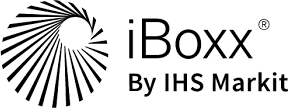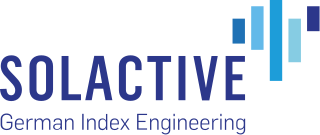Related Research Articles
The risk-free rate of return, usually shortened to the risk-free rate, is the rate of return of a hypothetical investment with scheduled payment(s) over a fixed period of time that is assumed to meet all payment obligations.
In finance, an interest rate swap (IRS) is an interest rate derivative (IRD). It involves exchange of interest rates between two parties. In particular it is a "linear" IRD and one of the most liquid, benchmark products. It has associations with forward rate agreements (FRAs), and with zero coupon swaps (ZCSs).

The London Inter-Bank Offered Rate is an interest-rate average calculated from estimates submitted by the leading banks in London. Each bank estimates what it would be charged were it to borrow from other banks. The resulting average rate is usually abbreviated to Libor or LIBOR, or more officially to ICE LIBOR. It was formerly known as BBA Libor (for British Bankers' Association Libor or the trademark bba libor) before the responsibility for the administration was transferred to Intercontinental Exchange. It is the primary benchmark, along with the Euribor, for short-term interest rates around the world. Libor was phased out at the end of 2021, and market participants are being encouraged to transition to risk-free interest rates.
A reference rate is a rate that determines pay-offs in a financial contract and that is outside the control of the parties to the contract. It is often some form of LIBOR rate, but it can take many forms, such as a consumer price index, a house price index or an unemployment rate. Parties to the contract choose a reference rate that neither party has power to manipulate.
A swaption is an option granting its owner the right but not the obligation to enter into an underlying swap. Although options can be traded on a variety of swaps, the term "swaption" typically refers to options on interest rate swaps.
The foreign exchange market is a global decentralized or over-the-counter (OTC) market for the trading of currencies. This market determines foreign exchange rates for every currency. It includes all aspects of buying, selling and exchanging currencies at current or determined prices. In terms of trading volume, it is by far the largest market in the world, followed by the credit market.
Foreign Exchange Reserves are cash and other reserve assets such as gold held by a central bank or other monetary authority that are primarily available to balance payments of the country, influence the foreign exchange rate of its currency, and to maintain confidence in financial markets. Reserves are held in one or more reserve currencies, nowadays mostly the United States dollar and to a lesser extent the euro.

The Czech koruna, also known as the Czech crown, has been the currency of the Czech Republic since 1993. The koruna is one of the European Union's 11 currencies, and the Czech Republic is legally bound to adopt the euro currency in the future.

The Czech National Bank, is the central bank and financial market supervisor in the Czech Republic with its headquarters in Prague, and a member of the European System of Central Banks. The Bank's governor is Aleš Michl. In accordance with its primary objective, the CNB sets monetary policy, issues banknotes and coins and manages the circulation of the Czech koruna, the payment system and settlement between banks. It also performs supervision of the banking sector, the capital market, the insurance industry, pension funds, credit unions and electronic money institutions, as well as foreign exchange supervision.
In finance, a currency swap is an interest rate derivative (IRD). In particular it is a linear IRD, and one of the most liquid benchmark products spanning multiple currencies simultaneously. It has pricing associations with interest rate swaps (IRSs), foreign exchange (FX) rates, and FX swaps (FXSs).
The Stockholm Interbank Offered Rate, STIBOR, is an interest rate benchmark calculated and published on each business day in Sweden. STIBOR is recognised as a critical benchmark of vital importance for financial stability and market integrity in Sweden. STIBOR fulfills all the following criteria as a critical benchmark:
The Kazakhstan Stock Exchange is a stock exchange located in Almaty, Kazakhstan. The exchange was founded in 1993.
The interbank market is the top-level foreign exchange market where banks exchange different currencies. The banks can either deal with one another directly, or through electronic brokering platforms. The Electronic Broking Services (EBS) and Thomson Reuters Dealing are the two competitors in the electronic brokering platform business and together connect over 1000 banks. The currencies of most developed countries have floating exchange rates. These currencies do not have fixed values but, rather, values that fluctuate relative to other currencies.
The interbank lending market is a market in which banks lend funds to one another for a specified term. Most interbank loans are for maturities of one week or less, the majority being over day. Such loans are made at the interbank rate. A sharp decline in transaction volume in this market was a major contributing factor to the collapse of several financial institutions during the financial crisis of 2007–2008.

iBoxx is a financial services division of IHS Markit that designs, calculates and distributes fixed income indices. iBoxx is overseen by IHS Markit Benchmark Administration Limited, which is regulated by the Financial Conduct Authority and is an authorized benchmark administrator under the UK Benchmarks Regulation. IMBA UK's benchmark administration activities have been conducted in compliance with the IOSCO Principles for Benchmarks since 2014.
SARON stands for Swiss Average Rate Overnight and represents the overnight interest rate of the secured funding market for the Swiss Franc (CHF). is an overnight interest rates average referencing the Swiss Franc CHF. It is based on transactions and quotes posted in the Swiss repo market. SARON is administered by SIX.
The forex scandal is a 2013 financial scandal that involves the revelation, and subsequent investigation, that banks colluded for at least a decade to manipulate exchange rates on the forex market for their own financial gain. Market regulators in Asia, Switzerland, the United Kingdom, and the United States began to investigate the $4.7 trillion per day foreign exchange market (forex) after Bloomberg News reported in June 2013 that currency dealers said they had been front-running client orders and rigging the foreign exchange benchmark WM/Reuters rates by colluding with counterparts and pushing through trades before and during the 60-second windows when the benchmark rates are set. The behavior occurred daily in the spot foreign-exchange market and went on for at least a decade according to currency traders.

Solactive is a German provider of financial indices based in Frankfurt. The company develops, calculates, and markets cost-efficient indices over several asset classes, including equity, fixed-income, and commodity indices. Solactive also engages in the development and branding of complex strategies, which are not based on traditional underlyings such as stocks and bonds, but instruments like funds, life insurance products, or basket of currencies.
The Saudi Arabian Interbank Offered Rate (SAIBOR) is a daily reference rate, published by SAMA, based on the averaged interest rates at which Saudi banks offer to lend unsecured funds to other banks in the Saudi Riyal wholesale money market.
In finance, a zero coupon swap (ZCS) is an interest rate derivative (IRD). In particular it is a linear IRD, that in its specification is very similar to the much more widely traded interest rate swap (IRS).
References
- ↑ "Czech Financial Benchmark Facility (CFBF) assumed the role of Benchmark Administrator of PRIBOR from the 24th July 2017". Financial Markets Association Of The Czech Republic, z.s. 2017-07-25. Retrieved 2018-12-13.
- ↑ "PRIBOR Code of Conduct" (PDF). cfbf.cz. Retrieved 2018-12-13.
- ↑ "Code of Conduct". Czech Financial Benchmark Facility. 2018-02-14. Retrieved 2018-12-13.
- ↑ "Banky drží úroky uměle vysoko. Nikdo je ale účinně nekontroluje". 24 March 2015.
- ↑ Reuters
- ↑ "REGULATION (EU) 2016/1011 OF THE EUROPEAN PARLIAMENT AND OF THE COUNCIL of 8 June 2016". eur-lex.europa.eu. Retrieved 2018-12-13.